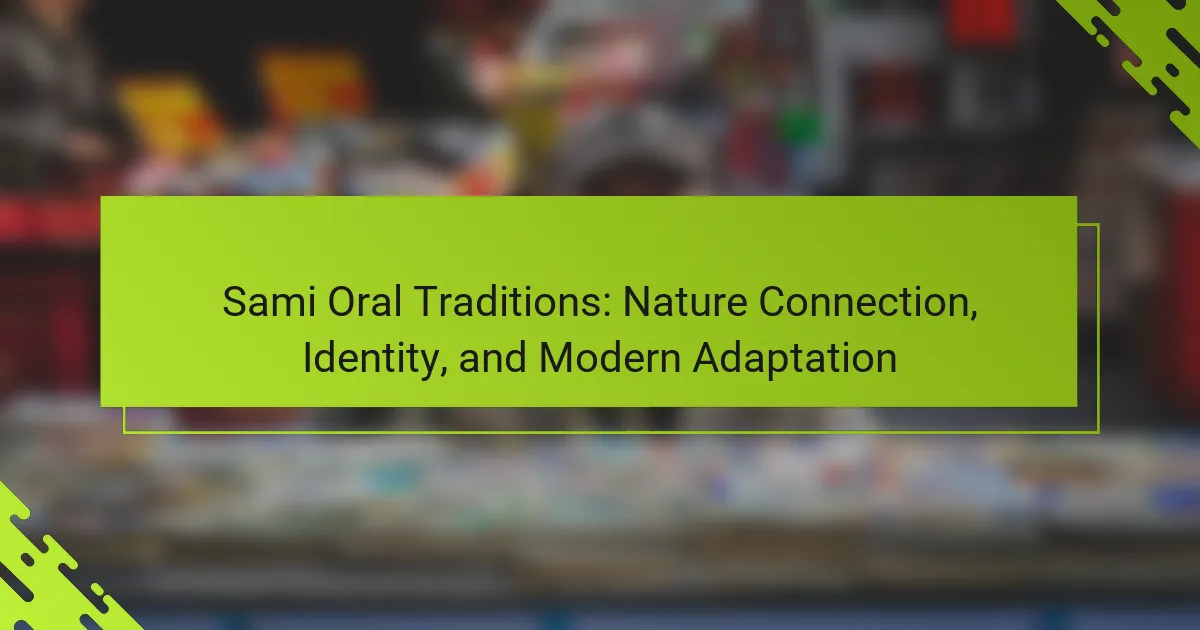Sami oral traditions play a crucial role in connecting the Sami people to nature and shaping their cultural identity. These narratives reflect ecological knowledge and community values while adapting to modern challenges. The integration of contemporary themes and storytelling techniques ensures the relevance of these traditions for younger generations. Preservation efforts, such as workshops and digital archiving, further enhance cultural continuity.
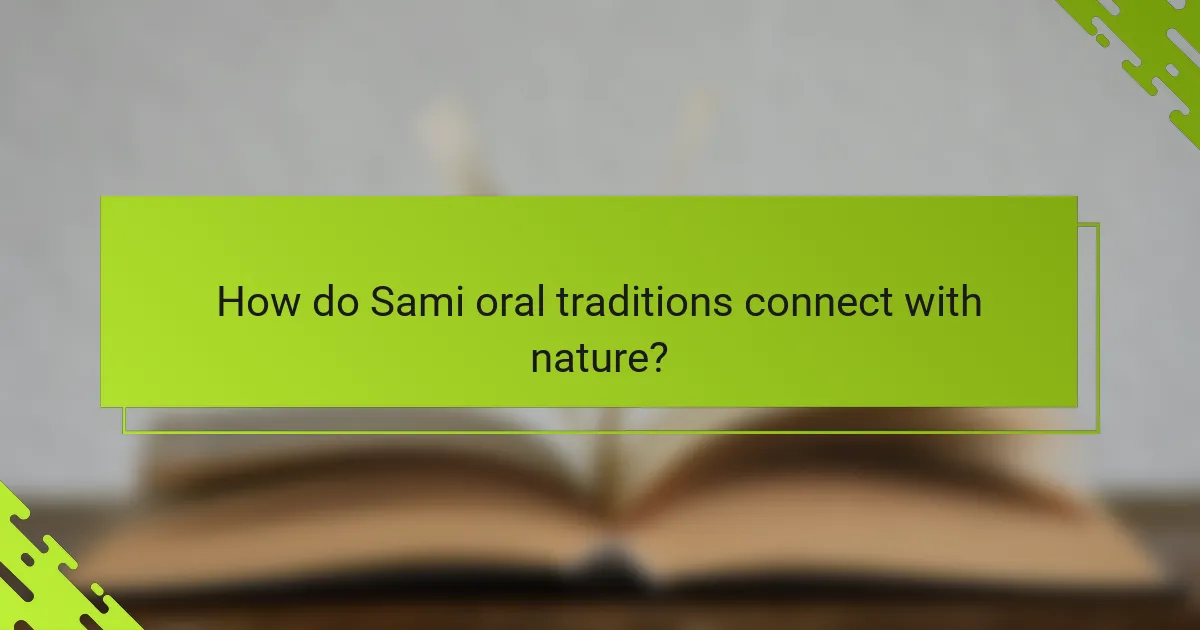
How do Sami oral traditions connect with nature?
Sami oral traditions deeply connect with nature, reflecting their identity and worldview. These narratives often illustrate the relationship between the Sami people and their environment, emphasizing respect for natural elements. Stories passed down through generations convey ecological knowledge, such as animal behaviours and seasonal changes, essential for survival in the Arctic landscape. As a result, these traditions foster a sense of belonging and responsibility towards nature, reinforcing cultural identity. Additionally, modern adaptations of Sami oral traditions incorporate contemporary environmental issues, bridging past wisdom with current challenges.
What are the key themes in Sami storytelling about the environment?
Sami storytelling emphasizes themes of deep environmental connection, cultural identity, and adaptation to modern challenges. Nature serves as a central character, illustrating the relationship between the Sami people and their surroundings. Traditional narratives often highlight the importance of land, animals, and seasonal cycles, reinforcing a unique worldview that respects and honours nature. Furthermore, contemporary Sami storytelling incorporates modern issues, showcasing resilience and the ongoing struggle for identity amidst globalisation. These themes reflect both the root attribute of cultural heritage and the unique attribute of environmental stewardship within Sami oral traditions.
How do Sami narratives reflect seasonal changes and natural cycles?
Sami narratives vividly reflect seasonal changes and natural cycles through storytelling. These oral traditions emphasize the interconnectedness of nature and human life, illustrating how seasonal shifts influence Sami identity, activities, and cultural practices. For example, winter stories often highlight survival strategies, while summer tales celebrate abundance and renewal. This cyclical understanding fosters a deep respect for the environment, reinforcing the Sami’s unique relationship with nature. Modern adaptations of these narratives continue to honour traditional wisdom while addressing contemporary issues, ensuring their relevance in today’s world.
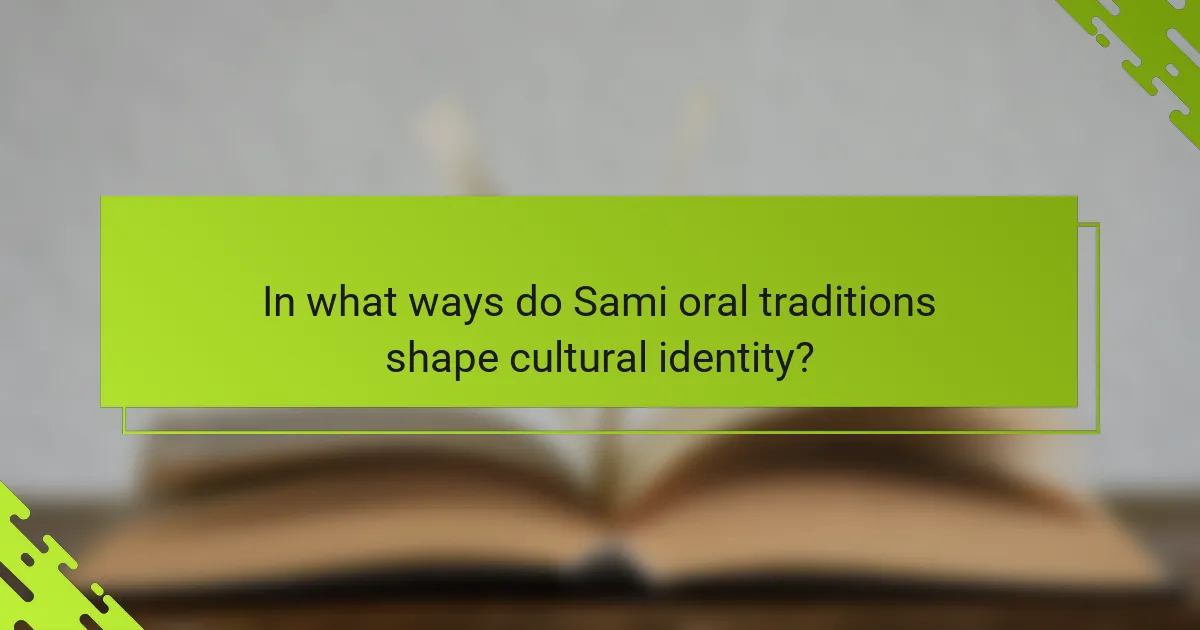
In what ways do Sami oral traditions shape cultural identity?
Sami oral traditions significantly shape cultural identity by preserving history, fostering community bonds, and expressing values. These traditions connect the Sami people to nature, emphasizing their relationship with the land and its resources. Storytelling and traditional songs convey ancestral wisdom and cultural practices, reinforcing a sense of belonging. Modern adaptations of these traditions reflect ongoing cultural resilience, allowing for the integration of contemporary themes while maintaining core values. This dynamic interplay ensures that Sami identity remains vibrant and relevant in today’s world.
How do storytelling practices reinforce community bonds among the Sami?
Storytelling practices among the Sami reinforce community bonds by sharing cultural values and collective history. These oral traditions foster a deep connection to nature and identity, creating a sense of belonging. Storytelling sessions often involve communal gatherings, strengthening relationships through shared experiences. Additionally, modern adaptations of these practices maintain relevance, allowing younger generations to engage while preserving heritage. This intergenerational exchange enhances community cohesion and resilience.
What role do traditional tales play in the transmission of Sami values?
Traditional tales play a crucial role in transmitting Sami values by preserving cultural identity and fostering a connection to nature. These narratives encapsulate beliefs, traditions, and lessons that guide behaviour and social norms. Through storytelling, the Sami community reinforces respect for the environment and emphasizes the importance of community and family ties. This oral tradition adapts to modern contexts, ensuring relevance while maintaining core values. The unique attribute of Sami tales lies in their ability to blend historical significance with contemporary issues, making them vital for cultural continuity.
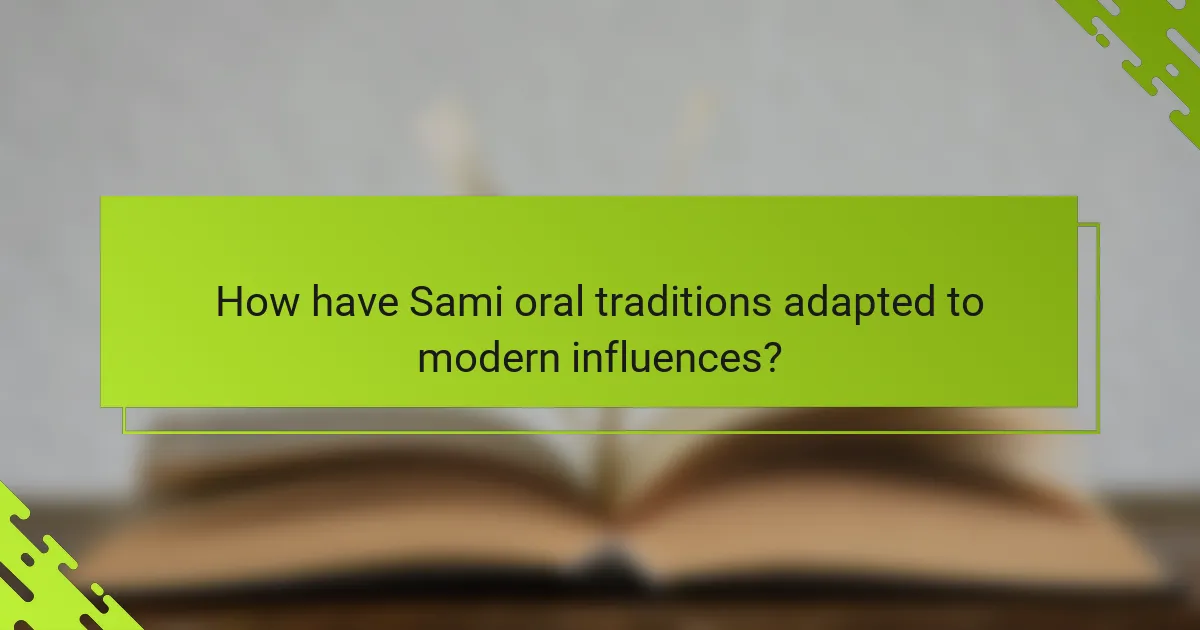
How have Sami oral traditions adapted to modern influences?
Sami oral traditions have adapted to modern influences by integrating contemporary themes while preserving their cultural essence. These adaptations include the incorporation of modern storytelling techniques and digital platforms, which enhance accessibility. Additionally, Sami artists and storytellers now address current issues such as climate change and identity, making traditions relevant to younger generations. This fusion of old and new exemplifies the resilience of Sami culture in a changing world.
What contemporary forms of expression have emerged from traditional narratives?
Contemporary forms of expression from Sami oral traditions include storytelling, music, and visual arts that emphasize nature, identity, and cultural heritage. These adaptations reflect modern themes while preserving traditional narratives. For instance, contemporary Sami musicians blend traditional joik with modern genres, creating a unique fusion that resonates with younger audiences. Additionally, visual artists utilize traditional motifs to address contemporary issues, fostering a dialogue between past and present. These expressions enhance cultural identity and promote awareness of Sami heritage in a global context.
How do digital platforms impact the preservation of Sami oral traditions?
Digital platforms significantly enhance the preservation of Sami oral traditions by facilitating wider access and engagement. These platforms enable the documentation and sharing of stories, songs, and cultural practices, ensuring they reach younger generations.
Social media and online archives allow Sami communities to showcase their heritage, fostering a sense of identity and connection. As a result, traditional narratives adapt to contemporary formats, blending modern technology with ancient wisdom.
Moreover, digital storytelling tools empower individuals to create and share their interpretations of Sami traditions, promoting cultural exchange. This modern adaptation helps maintain relevance while preserving authenticity, ensuring that these oral traditions thrive in a digital age.

Which unique attributes distinguish Sami oral traditions from other indigenous cultures?
Sami oral traditions are distinguished by their deep connection to nature, unique storytelling techniques, and integration of modern elements. These traditions emphasize the importance of the natural environment, with narratives often reflecting the Sami relationship with reindeer and the Arctic landscape. Unlike many other indigenous cultures, Sami storytelling frequently incorporates elements of contemporary life, showcasing adaptability. The use of yoik, a traditional form of song, is a unique attribute that sets Sami oral traditions apart, as it serves both as a form of expression and a way to connect with personal and communal identity.
How do Sami oral traditions incorporate elements of shamanism?
Sami oral traditions incorporate elements of shamanism through storytelling, rituals, and spiritual beliefs. These traditions emphasize a deep connection to nature, where shamans serve as mediators between the physical and spiritual worlds. Rituals often involve the use of drums, songs, and chants that reflect the Sami worldview and their relationship with the land. This fusion of oral history and shamanic practices helps preserve Sami identity and cultural heritage while adapting to modern influences. The unique attribute of Sami shamanism lies in its integration of animistic beliefs, where natural elements are considered alive and spiritually significant.
What specific linguistic features are found in Sami storytelling?
Sami storytelling features rich linguistic elements that reflect cultural identity and nature connection. These narratives often incorporate unique metaphors, rhythmic patterns, and a deep sense of place. Oral traditions utilize repetition and alliteration to enhance memorability and engagement. Additionally, Sami stories frequently include elements of nature, showcasing the environment’s significance in shaping identity and values. The use of dialogue and character voices adds depth, making the tales relatable and dynamic.

What challenges do Sami oral traditions face in the modern world?
Sami oral traditions face significant challenges today, including cultural erosion and globalisation. The loss of traditional languages threatens the transmission of these narratives. Additionally, modern technology alters storytelling methods, making it harder to maintain authentic practices. Socioeconomic pressures further complicate the preservation of these traditions, as younger generations may prioritise different lifestyles over cultural heritage.
How is climate change affecting the themes in Sami narratives?
Climate change significantly influences themes in Sami narratives by altering their relationship with nature and identity. Traditional stories often emphasize harmony with the environment, a connection now challenged by climate shifts.
Increased temperatures and changing ecosystems disrupt traditional reindeer herding, a vital cultural practice. Sami narratives reflect this struggle, showcasing resilience and adaptation to new realities.
Furthermore, climate change prompts a re-examination of identity within Sami communities. As younger generations face environmental changes, narratives evolve to incorporate modern challenges, blending tradition with contemporary issues.
This adaptation highlights the unique attribute of Sami oral traditions: their ability to remain relevant amid external pressures, ensuring cultural survival.
What are the implications of globalisation on Sami cultural expressions?
Globalisation impacts Sami cultural expressions by both challenging and revitalising their oral traditions. Increased exposure to global cultures can dilute traditional practices, yet it also fosters adaptation and innovation.
Sami oral traditions, rooted in nature connection and identity, face risks of erosion as modern influences grow. However, globalisation encourages Sami artists to blend traditional narratives with contemporary themes, enhancing cultural visibility.
For example, Sami musicians often incorporate modern genres, attracting wider audiences while preserving their heritage. This adaptation illustrates resilience, as the Sami community navigates a balance between tradition and modernity.
In summary, globalisation presents both challenges and opportunities for Sami cultural expressions, prompting a dynamic interplay between preservation and innovation.
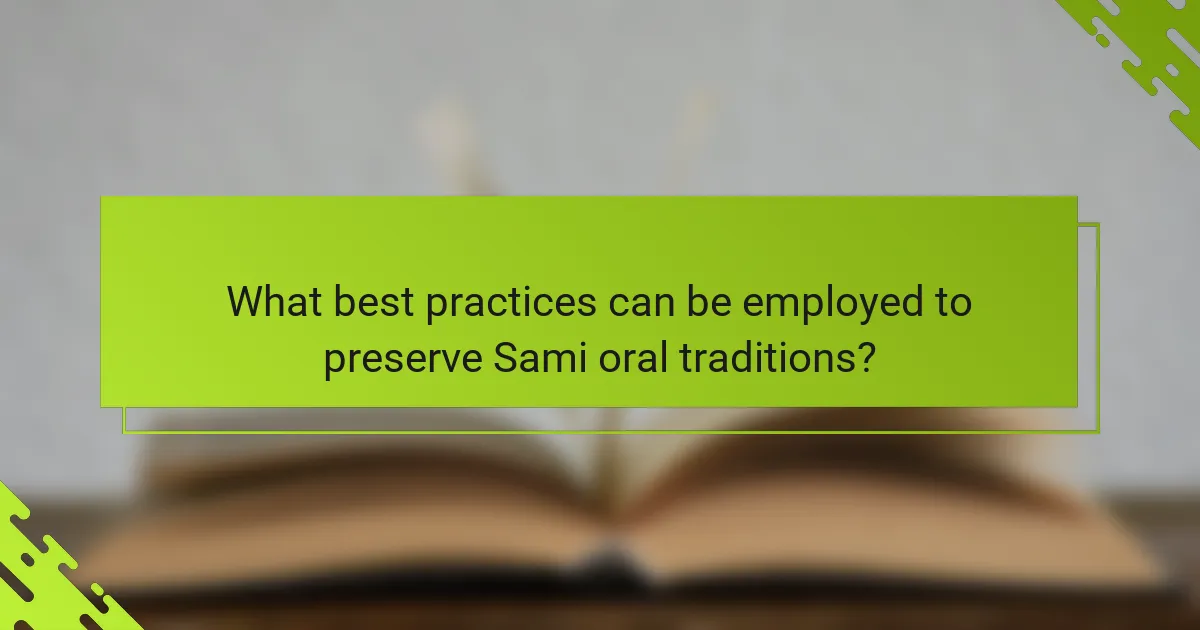
What best practices can be employed to preserve Sami oral traditions?
To preserve Sami oral traditions, communities can employ storytelling workshops, intergenerational knowledge sharing, and digital archiving. These practices enhance cultural identity and adapt to modern contexts.
Storytelling workshops engage youth in traditional narratives, fostering a connection to heritage. Intergenerational knowledge sharing encourages elders to pass down stories, ensuring continuity. Digital archiving preserves these narratives for future generations, making them accessible and relevant.
These methods collectively strengthen the cultural fabric of Sami identity while adapting to contemporary society.
How can communities engage youth in storytelling practices?
Communities can engage youth in storytelling practices by incorporating Sami oral traditions that emphasize nature connection and identity. These traditions can foster a sense of belonging and environmental awareness. Workshops and events that allow youth to share their own stories in this cultural context can enhance their creativity and confidence. Collaborations with local elders can provide mentorship, ensuring the transmission of these traditions while adapting them to modern mediums like digital storytelling.
What role do educational institutions play in promoting Sami narratives?
Educational institutions play a crucial role in promoting Sami narratives by integrating these stories into curricula. They foster cultural awareness and understanding among students. Programs often include workshops, storytelling sessions, and collaborations with Sami communities. This engagement helps preserve unique oral traditions and strengthens Sami identity. Additionally, institutions can adapt these narratives to modern contexts, ensuring their relevance for future generations.
